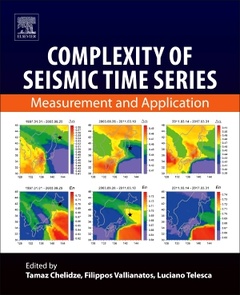Complexity of Seismic Time Series Measurement and Application
Coordonnateurs : Chelidze Tamaz, Vallianatos Filippos, Telesca Luciano

Complexity of Seismic Time Series: Measurement and Application applies the tools of nonlinear dynamics to seismic analysis, allowing for the revelation of new details in micro-seismicity, new perspectives in seismic noise, and new tools for prediction of seismic events. The book summarizes both advances and applications in the field, thus meeting the needs of both fundamental and practical seismology. Merging the needs of the classical field and the very modern terms of complexity science, this book covers theory and its application to advanced nonlinear time series tools to investigate Earth?s vibrations, making it a valuable tool for seismologists, hazard managers and engineers.
I. Complexity Measurement in Seismograms and Natural and Artificial Time Series of EQs (Catalogs) 1. Analysis of Complexity in Seismic Time Sets: Case Study for Caucasus 2. Non-Extensive Statistical Seismology: An Overview 3. Point-Processes Applied to Seismology: Epidemic Type Aftershock Sequence (ETAS) Model, Results and Limits 4. Fractal, Informational and Topological Methods for the Analysis of Discrete and Continuous Seismic Time Series: An Overview 5. Modelling of Persistent Time Series by the Nonlinear Langevin Equation 6. Synchronization of Geophysical Fields Fluctuations 7. Natural Time Analysis of Seismic Time Series
II. Complexity of Time Series of Stick-Slip (Models of Seismic Process) 8. Complexity in Laboratory Seismology. From Electrical and Acoustic Emissions to fracture 9. Complexity and Synchronization Analysis in Natural and Dynamically Forced Stick-Slip: a Review
III. Complexity in Earthquake Generation and Seismic Hazard Assessment 10. Complexity and Time-Dependent SHA: Should We Use Fuzzy, Approximate and Prone-to-Errors Prediction Models to Overcome the Limitations of Time-Independent Models? 11. Are Seismogenetic Systems Random or Organized? A Treatise of their Statistical Nature Based on the Seismicity of the North-Northeast Pacific Rim 13. Phase Space Portraits of Earthquake Time Series 12. Four-Stage Model of Earthquake Generation in Terms of Fracture-Induced Electromagnetic Emissions: A Review
Geophysicists, seismologists, hazard managers, engineers
Filippos Vallianatos is a Professor of Geophysics and Seismology in the School of Environment and Natural Resources Engineering at the Technological Educational Institute of Crete. He is the holder of UNESCO Chair of Solid Earth Physics and Geohazards Risk Reduction. His research activity Is focused on Solid Earth physics, approaching it using the principles of Complexity Geophysics and Seismology involved in the dynamics of the Earth's crust and by studying the fundamental mechanics of earth processes & geohazards from rock physics to geodynamic scales. He has authored or co-authored more than 150 publications in international journals along with many chapters or monographs.
Luciano Telesca is a research scientist for the Institute of Methodologies for Environmental Analysis of the National Research Council of
- Covers the topic of Earth’s vibrations involving many different aspects of theoretical and observational seismology
- Identifies applications of advanced nonlinear time series tools for the characterization of these Earth’s signals
- Merges the needs of geophysics with the applications of complexity theory
- Describes different methodologies to analyze problems, not only in the context of geosciences, but also those associated with different complex systems across disciplines
Date de parution : 05-2018
Ouvrage de 546 p.
19x23.3 cm
Thèmes de Complexity of Seismic Time Series :
Mots-clés :
Earthquakes; statistical seismology; complexity; time series analysis; catalogues and seismograms; hidden structures in seismic time series; seismic noise; seismic hazard; engineering seismology; triggered and induced seismicity; synchronization; man-made effects; stick-slip dynamics; synthetic seismic time series



